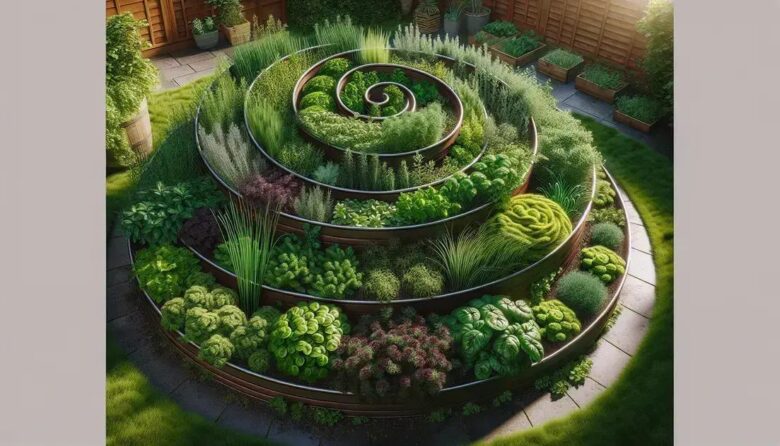Ever wondered how a herb garden spiral can revolutionize your gardening experience? These innovative structures blend permaculture principles with simplicity, making them ideal for beginners. Whether you’re dreaming of fresh basil or aromatic rosemary, a well-designed spiral can transform your approach to herbs. Let’s dive into the practical steps and essential tips to create your own thriving green oasis.
Understanding the herb garden spiral
Herb garden spirals are a fascinating and efficient way to grow a variety of herbs in a limited space. This permaculture design creates a vertical garden where plants are placed in a spiral pattern, maximizing space and providing different microclimates to suit various herbs. The structure is usually built from natural materials like rocks or bricks, with soil layered in a spiral form that rises from ground level to the center.
Benefits of a Spiral Design include efficient water use, as water flows down the spiral, soaking into the soil and helping plants to thrive. The design also facilitates easy access to all plants from a single location, making maintenance convenient.
In this spiral, sun-loving herbs like oregano or thyme can be planted at the top, where they receive the most sunlight, while moisture-loving herbs such as mint or parsley thrive at the base. By understanding how microclimates work within the spiral, you can optimize your herb growth.
Building a herb spiral is achievable by anyone with a passion for gardening, regardless of experience level. Start with choosing the right location and materials, ensuring the structure receives adequate sunlight and drainage.
Benefits of using a herb spiral
Using a herb spiral offers numerous benefits for both seasoned gardeners and beginners. This clever design maximizes space by creating a vertical garden, allowing you to grow a variety of herbs in a compact area. The spiral shape provides different microclimates, which accommodate the varying needs of herbs. Plants at the top receive more sunlight and drainage, ideal for Mediterranean herbs like rosemary and thyme. Meanwhile, the lower levels retain more moisture and less sun exposure, perfect for herbs such as mint and chives.
A herb spiral also promotes efficient water use. Water applied at the top trickles down, soaking into the soil layers and nourishing each plant. This design reduces water waste and supports sustainability.
Moreover, herb spirals make gardening accessible. The structure’s elevation means less bending and a more user-friendly gardening experience. This setup is also aesthetically pleasing, adding a unique focal point to any garden space.
By using a herb spiral, gardeners can create a thriving ecosystem right in their backyard, enjoying fresh, home-grown herbs easily accessible for cooking or medicinal purposes.
Choosing the right location for your spiral
Choosing the right location for your herb spiral is crucial for its success. Consider sunlight exposure, as most herbs need at least six hours of sunlight each day. Thus, an area with ample sun is ideal. However, some parts of the spiral will naturally receive less sun, accommodating herbs that prefer shade.
Ensure the site has good drainage. Avoid placing the spiral in low-lying areas where water tends to accumulate. The slope of the spiral should help with natural drainage, but proper site selection will enhance this feature.
Accessibility is another key factor. Position your spiral where it’s easy to reach for both planting and harvesting. Locating it close to your kitchen can encourage frequent use of fresh herbs.
Lastly, consider the visual impact. An herb spiral can be a stunning garden centerpiece. Choose a location that enhances your garden’s aesthetic appeal, making the spiral both functional and attractive.
Step-by-step guide to building a herb spiral
Building a herb spiral is an engaging project that turns a simple garden space into a vibrant, functional masterpiece. Start by selecting a sunny location with proper drainage. Mark out a circle using a garden hose or string, typically around two meters in diameter. The spiral should be tall enough to create distinct microclimates, usually about one meter high.
Gather materials like rocks, bricks, or recycled materials to form the structure. Begin laying these materials at the perimeter and spiral inward, keeping the wall stable and uniform. As you build, fill the structure with layers of soil and compost. This mixture provides nutrients essential for herb growth.
Plan your planting arrangement. Place sun-loving herbs such as lavender and rosemary at the top where they will receive more sunlight and benefit from better drainage. Herbs that prefer dampness, like mint and basil, are best planted at the base.
After constructing the spiral, water thoroughly to help the soil settle. Monitor the garden for the first few weeks, adjusting as necessary to ensure plants are thriving.
Plants that thrive in a herb spiral
Different herbs thrive in various zones of a herb spiral, thanks to the structure’s natural microclimates. At the top, where sunlight is plentiful and drainage is excellent, consider planting Mediterranean herbs like rosemary, thyme, and lavender. These herbs thrive in dry conditions and enjoy the warm, elevated spots.
Midway down the spiral, the conditions are slightly moister with some shade, making it perfect for herbs like oregano and chives. These plants enjoy moderate sun and consistent watering, benefiting from water trickling down from above.
At the spiral’s base, where the soil retains the most moisture, plant water-loving herbs such as mint, basil, and parsley. These herbs appreciate the cooler and damper environment found at the lower levels.
This layered system ensures each plant receives its ideal growing conditions, leading to a productive and lush herb garden.
Maintaining your herb garden spiral
Maintaining your herb garden spiral is essential to keep your plants healthy and productive. Regular watering is crucial, especially during dry spells. Focus on the top levels, as water will naturally filter down to lower levels. Consistent weeding is necessary to prevent unwanted plants from competing with your herbs for nutrients and light.
Monitor for pests and diseases. Inspect foliage regularly for signs of trouble, such as chewed leaves or discolored patches. Use natural remedies, such as neem oil or insecticidal soap, to treat these issues without harming beneficial insects.
Pruning is another important task. Trim herbs like basil and mint regularly to encourage bushy growth and prevent them from getting leggy. This practice also promotes new growth and enhances flavor.
Fertilizing your herb spiral with organic compost every few months can replenish nutrients washed away by rain or absorbed by the plants. Doing so maintains soil health and boosts plant vigor.
Creating Your Own Herb Spiral
Building a herb garden spiral offers a unique way to grow a variety of herbs in a small space. With careful planning, you can optimize sunlight and water for each plant, creating a thriving ecosystem.
By carefully selecting plants suited for their specific locations within the spiral, you can ensure each herb gets the ideal conditions for growth. This setup reduces maintenance and enhances productivity.
Regular care involves watering, pruning, and monitoring for pests, ensuring your herb spiral remains vibrant and productive.
Whether you’re a beginner or an experienced gardener, a herb spiral can add beauty and utility to your garden. Embrace this permaculture design and enjoy fresh, flavorful herbs right at your fingertips.
FAQ – Common Questions about Herb Garden Spirals
What is a herb garden spiral?
A herb garden spiral is a vertical garden that maximizes space and creates various microclimates by spiraling upward.
Why should I use a herb spiral in my garden?
Herb spirals allow you to grow different herbs in a compact area, optimizing sunlight and water usage for each plant.
Which herbs are best suited for the top of the spiral?
Sun-loving herbs like rosemary and thyme are ideal for planting at the top, where they receive more light and drainage.
How do I maintain my herb spiral?
Regularly water, prune, and check for pests. Pay attention to plant health and add organic compost to sustain growth.
Can I build a herb spiral with recycled materials?
Yes, you can use materials like rocks, bricks, or recycled items to construct your herb spiral, making it an eco-friendly option.
Where should I place my herb spiral in the garden?
Choose a sunny spot with good drainage, accessible for care, and where it can serve as a focal point in your garden.



